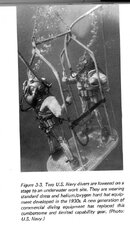Some early hardhat divers had really gruesome accidents. Their air was pumped from the surface. If for some reason the pump failed, and had no failsafe to seal the hose, the diver ended up with a pipe on top of his head leading to the surface, and ambient pressure would instantly squeeze him into mush. In some cases the diver's entire body ended up inside the helmet.
What I do not understand is this:
I can easily see how it would happen if the hose to the surface were a rigid pipe. Water tries to go up the pipe, and human body being essentially water... ends up with a very red mess. But the hoses were not rigid. The same pressure which tries to collapse the diving suit around the unfortunate diver, should also instantly collapse the hose and thus close the connection with the surface pressure. Why was that not happening?
My apologies for a grotesque subject, but this question has been bugging me for a long time.
What I do not understand is this:
I can easily see how it would happen if the hose to the surface were a rigid pipe. Water tries to go up the pipe, and human body being essentially water... ends up with a very red mess. But the hoses were not rigid. The same pressure which tries to collapse the diving suit around the unfortunate diver, should also instantly collapse the hose and thus close the connection with the surface pressure. Why was that not happening?
My apologies for a grotesque subject, but this question has been bugging me for a long time.





